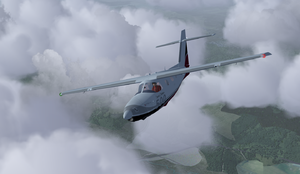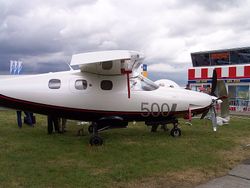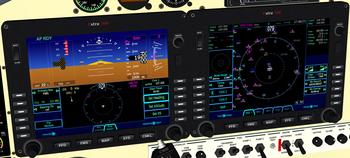Ru/Extra EA-500
 Extra 500 летящий в облаках | |
| Тип | Гражданский самолет |
|---|---|
| Автор(ы) | D-EKEW, D-LEON, D-STHO |
| FDM | /JSBSim, /JSBSim, /JSBSim, /JSBSim, /JSBSim, /JSBSim, /JSBSim, /JSBSim |
| --aircraft= | extra500 |
| Статус | Релиз |
| FDM |
|
| Системы |
|
| Кабина |
|
| Модель |
|
Extra500 шестиместный однодвигательный турбовинтовой самолет производства компании Extra Aircraft (основана на EDLD).
Status
- Flightgear 3.4 и более поздние
- Текущий стабильный релиз 2.0.0 (10.01.2015) может быть найден в хранилище fgaddon FGAddon.
- FlightGear 3.2 и более ранние
- Последний стабильный релиз 1.2.0 может быть найден в Gitorious.
Alternatively: Download
Для стабильного релиза убедитесь что вы на release/2.0.0 ветке!
С марта 2013 D-EKEW, D-LEON, D-STHO работают над этой моделью. Они делают ее по данным из Pilot's Operation Handbook. Люди имеющие опыт работы с этим самолетом в реальной жизни помогают калибровать FDM, а также настраивать поведение самолета.
О самолете
Extra EA-Series
Компания Extra Aircraft разработала несколько аэробатических самолетов базирующихся на ранних экспериментальных EA-230 и EA-260, затем FAR-23 сертифицировала EA-300 серию (EA-300, EA-300/S, EA-300/L, EA-300/200, EA-300/LT, EA-330/LC, EA-330/SC). Компания представила Extra EA-400 в 2001. Это cross-country самолет со многими уникальными особенностями включая конструкции из углепластика, герметичную кабину, high strut-less крыло, и шесть сидений. EA 400-500 представлен как производный от EA-400 с заменой поршневого двигателя на Rolls-Royce Model 250-B17F/2 турбовинтовой двигатель развивающий 450 лошадиных сил (340 kW) и вращающий 5-ти лопастной MT-propeller. Walter Extra первым пролетел на Extra500 из Германии в Ошкош, Висконсин для иллюстрации его дальности и возможностей. Последние изменения в самолете связаны с Avidyne и ее авионикой: Avidyne Entegra R9.
Основные характеристики
| Общие | |
|---|---|
| Мин. Экипаж | 1 |
| Вместимость | 5 человек или 525 кг нагрузки |
| Длина | 10.1 м |
| Размах | 11.7 м |
| Высота | 3.4 м |
| Вес пустого | 1,420 кг |
| Макс. взлетный вес | 2,130 кг |
| Силовая установка | |
| Тип двигателя | Турбовинтовой |
| Двигатель | Rolls-Royce Model 250-B17F/2 |
| Летные данные | |
| Крейсерская скорость | 210 kts |
| Скорость сваливания (MTOW, Full flaps) | 61 kts |
| Дальность | 2,963 км |
| Длительность | 7.9 часов на крейсерской скорости |
| Потолок | 25,000 ft |
| Скороподъемность (S.L.) | 1,335 ft/min |
Скачать
Extra500 доступен на Gitorious: https://www.gitorious.org/extra500/extra500
Мы рекомендуем Flightgear версии 3.1 или более поздний, для получения преимуществ улучшенной системы canvas.
Стабильный релиз для Flightgear 3.2 доступен в Gitorious:
git clone https://git.gitorious.org/extra500/extra500.git
cd extra500
git checkout release/1.2.0
или используйте кнопку загрузки на: release 1.2.0.
Стабильный релиз для Flightgear 3.4 доступен из FGAddon или из Gitorious:
git clone https://git.gitorious.org/extra500/extra500.git
cd extra500
git checkout release/2.0.0
или используйте кнопку загрузки на: release 2.0.0.
Текущая версия в разработке находится в основной ветке
git clone https://git.gitorious.org/extra500/extra500.git
cd extra500
git checkout master
или используйте кнопку загрузки на: master.
Управление
Для полных инструкций по управлению, смотрите оффициальный Extra500 POH. Он может быть скачан со страницы производителя: [1], справа внизу.
Описание ниже просто быстрый старт и некоторые выбранные темы. Смотрите здесь справку по панелям.
ПРЕДУПРЕЖДЕНИЕ: Описание ниже отражает текущую версию в разработке (master). Если вы используете стабильную версию, некоторые функции могут быть недоступны!
Общие замечания
Все переключатели вращаются поворотом колеса мыши в нужном направлении. Нажимайте и отпускайте кнопки щелчком левой кнопки мыши. Вращающиеся ручки так же поворачиваются колесом мыши. Удерживайте ⇧ Shift для уменьшения шага.
IFD кнопки слева, справа и ниже экрана имеют два положения. То есть они все имеют левую и правую сторону. Нижние кнопки (PFD - FMS - MAP - SYS - CHKL) перемещают между главными страницами. Эти же кнопки позволяют вам перемещаться между закладками на выбранной странице. Боковые кнопки не всегда имеют назначение, но если имеют, они подсвечиваются и их функция показана рядом с ними.
Есть несколько специальных горячих клавиш Extra500:
CTRL+E Подключить / отключить внешнюю тележку питания.
CTRL+F Контролировать тангаж только триммерами.
CTRL+G Поставить самолет на Jacks (для тестирования шасси на земле)
W Заглушить предупреждение о шасси (или нажмите переключатель на секторе газа)
R Установить пропеллер на реверс (beta range)
S Рычаг регулятора топлива вкл/выкл (или щелкните на рычаге регулятора топлива)
D Отключить автопилот (или нажмите красную кнопку на штурвале)
C Подключить Control Wheel Steering (CWS, см. ниже)
Диалог проверочных листов
The checklists going along with the manufacturers POH. The Extra500 provide a dialog to read, view and perform the necessary task for each flight phase. Checklists can performed manually and automated just let the dialog do the work.
- Show/hide the checklist.
- Show/hide the config options.
- Minimize the dialog. For automated in flight usage.
- Close the dialog and its action.
- Allow the dialog to move the view to the action.
- The dialog will show a pink circle at the action.
- Write message on screen, nice for text to speech(festival).
- Make the dialog transparent.
- Faster work through the automated checklist.
- Pick a required checklist and load it.
- Plays and stops the checklist. All actions will be done in an automated sequence.
- Moves the view to the action and shows the pink circle.
- Perform the action.
- Sub-page navigation of the checklist
- Next checklist for the next flight phase.
Messages
There are several types of messages that may appear on your screen:
- Failure (red): a failure has occurred
- Warnings (red): an aircraft limit has been exceeded, immediate action required
- Cautions (yellow): a limit has been exceeded, action needed within 5 minutes
- Info (blue): some general information on why something does not work or some other peculiarity
- Trim: shows if the pilot (you) needs to pull or push the yoke. You will need to use the elevator trim (mouse wheel) accordingly.
All these messages are on by default, but can be switched off in the Extra500 - Configuration menu
The messages by far do not cover all situations, but are there to help the pilot learn the most basic behavior/limits. Typically there is no special message when it already is in the aircraft warning panel.
Engine starting
See also here
- Parking Brake: Set ( ⇧ Shift+B or pull out middle Bowden cable in middle console AND press B )
- Battery: Switch ON
- Fuel Pump 1 or 2: Switch ON
- Engine Start: START
- at 12-15% N1: Press s ( or click on condition lever, its the red one )
CAUTION: TOT limit for starting is max. 10sec above 810 °C and below 927 °C
If the engine does not light-off:
- Engine Motoring: ABORT and back to NORMAL
- Condition Lever: Press s Fuel off
Wait until N1 drops below 3% and TOT below 100 °C, then start again.
After engine has started:
- Standby alternator: Switch ON
- Generator: Switch ON
- Engine start: IGN OFF (only if N1 >= 65%)
Take-off
- Flaps: 15 degrees ( ] or use the flap switch )
- Power lever: TRQ 111%
CAUTION: for Take-off (5 minutes) maximum TRQ limit is 111%, TOT 810degC
- Parking Brake: Release ( ⇧ Shift+B or push in middle Bowden cable in middle console )
NOTE: For strong side wind, turn the ailerons against the wind
- At 71KIAS: Rotate
- Gear: Retract ( G or click the gear switch )
- Flaps: 0 degrees ( [ or use the flap switch )
CAUTION: Flaps need to be retracted before reaching 120KIAS, gear 140KIAS
- Power lever: TRQ 92%
CAUTION: For continuous operation the TRQ limit is 92%, TOT 752degC, watch the TOT while climbing!
Climb
Climb with MCP (maximum continuous Power, 92%TRQ or 752degC) at 110 KIAS.
Descent
Descent with 50% TRQ and 2000ft/min. Max airspeed is 207 KIAS.
Landing
Do not come in too high, too fast.
- At 140 KIAS, gear: Extend (⇧ Shift+G or click the gear switch )
- At 120 KIAS, flaps: 15 degrees ( ] or use the flap switch )
- When you are sure you will land and below 109 KIAS, flaps: 30 degrees ( ] or use the flap switch )
- Power for a 3deg descent, 80KIAS and landing configuration is ~30% TRQ
- Dont forget to brake. For reverse press R, will only toggle when power lever is in aft position!
Engine shut-off
- Parking Brake: Set ( ⇧ Shift+B or pull out middle Bowden cable in middle console AND press B )
- Fuel Pump 1 and 2: Switch OFF
- Standby alternator: Switch OFF
- Generator: Switch OFF
- Press s ( or click on condition lever )
- Battery: Switch OFF
Principle Autopilot functionality
- HDG Follows the heading bug (set HDG bug using the keypad, press to sync)
- NAV Intercepts and tracks VORs, LOCs or your Flight Plan (set course with LH lower rotary knob on IFD)
- NAV/GPSS Intercepts and tracks your Flight Plan and cuts the corners ( press NAV twice)
- HDG+NAV Intercept the course or active flightplan leg with your set heading
- NAV+REV Intercepts and tracks the LOC back course
- GS Is armed and activated automatically when captured on the LOC. You can switch it off by pressing APR, ALT mode will become active. To arm the GS again, press APR for a second time
- VS Follows the VS bug (limited to +/-1600fpm, set with AP rotary knob)
- ALT Holds the current altitude (rounded to 100ft)
- ALT+VS Brings and holds the aircraft to the selected altitude (set ALT bug using the keypad, press to sync) with the selected vertical speed.
- CWS Control Wheel Steering. Follows the turn rate and vertical speed set by controlling the aircraft.
To disconnect press: d
General remarks to autopilot operation:
A roll mode (HDG, NAV/GPSS, APR/REV) must be engaged for a pitch mode (ALT, VS, GS) can engage.
A roll mode (HDG, NAV/GPSS, APR/REV) must be engaged for the yaw trim to work
If pitch trim is switched off, autotrim is not available, but the AP will indicate where to (manually) trim to.
For CWS, a roll and pitch mode must be engaged. Press and Hold c (caution: AP servos will disengage!) and with your controls bring the aircraft at your wished turn and climb rate. Release c and the AP will engage and keep those rates.
The AP will disengage when:
- the disconnect switch is pressed (d)
- the stall warner is on (stall warn horn and light)
- absolute g-force (disregarding 1-g gravity) exceeds 0.6g
- manual electric pitch trim is used.
The COM unit (1 or 2 ) is selected on the audiopanel. Just hit the appropriate "XMT" button. Note that FGCOM only works on COM1! If you want to hear the NAV station morse code or the marker tones, press the appropriate button on the audiopanel also. The volume can be adjusted using the inner volume knob.
The active COM standby frequency can be inputted on the keypad. The first "1" is not needed and any trailing "0" neither. Just type in the frequency and switch active/standby with the button just left of the frequencies.
Not-active-COM and NAV standby frequencies are similar, just press the NAV1 / NAV2 button first.
FMS, Nav 1 or Nav 2 may be selected on the IFD or in the NAV dialog (F12) The DME source can be set using the AUX button on the keypad. Select with the FMS knob. The DME hold switch next to the DME indicator overrides all NAV frequency switching and holds the frequency to which the DME was tuned when the HOLD button is pressed.
The FMS (Flight Management System) can be used with or without the autopilot. You can put your flightplan in the autopilot - route manager (don't forget to press activate). The autopilot will intercept the active leg.
While flying a flightplan (FMS is the Nav source and NAV is selected on the autopilot), you can do some special stuff without touching the autopilot:
- Vectors mode: Press V with arrow or "Fly Vectors" knob on IFD to follow the heading bug while still in nav mode. Deselecting will return normal FMS functionality. Handy for making a brief excursion from the flightplan for weather or ATC.
- Direct-To mode: In the route manager select the waypoint and on the keypad press the D with arrow button.
- Close to the waypoint direct-to mode will be de-selected automatically or you can do that manually by pressing the same button again.
- FMS-OBS: Rotate the LH lower knob on the IFD. Press to cancel. Very similar to VOR functionality, except it will work on all waypoints of your flightplan. Very handy for making an approach on an airport without ILS.
If your flightplan has a VOR or ILS, the FMS will automatically tune NAV1 to the respective frequency and set the radial accordingly. So there is no need to look up any NAV frequency anymore! In addition when you line up with the selected runway, The NAV source will automatically change to NAV1, thus the ILS interception will be fully automatic. You do need to be lined up to the runway pretty accurately: the Flightgear "DEFAULT" approaches are ideal for this! For this kind of approach it is recommended that you slow down, get the gear out and set the flaps to 15deg before the GS is intercepted. Depending on the aircraft weight and wind conditions set 20-30% TRQ when on the GS to match 80 KIAS.
XPDR squawk can be set on the keypad (press XPDR and squawk code) and in the NAV dialog (F12). Default is 7000 (Europe VFR). XPDR modes are selected automatically (GND or ALT), but automatic selection may be switched off Manual mode selection is then possible. The MODE button on the keypad will set the mode manually also.
Pressurization system
The extra500 is certified to 25000ft, where the air is pretty thin. So there is pressurization system that keeps the cabin altitude below 8000ft which corresponds to a cabin differential pressure of 5.5psid at 25000ft. So if you are planning to fly above 10000ft, you need to make sure that the ENV AIR and PRESS switches (left lower corner) on the side switch panel are on. In addition, before take-off you should set the cabin controller (center console) to the airport altitude and just after take-off to your target altitude. Before descending from cruise, set the controller to your target airport altitude. You can monitor the cabin altitude, differential pressure and cabin climb rate on the instruments next to the controller.
Above a cabin altitude of 8000ft, it can endup in a abnormal low level of oxygen in your blood. If this happen you will feal a blackout and it's necessary to bring immediate the cabin altitude below 8000ft by descend or pressurise the cabin.
Night Flying
For lighted instruments switch on the INSTR switch on the side switch panel. On the same panel you can switch the DAY/NIGHT switch to NIGHT for dimming. The 5 round turn knobs on the panel now can be used to set your dimming level. The IFD-s have their own dimming switch on the left upper side of the bezel. For taxying use the RECO lights. For landing the LDG light.







